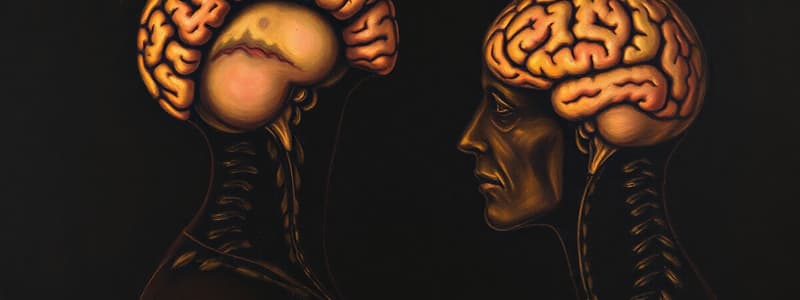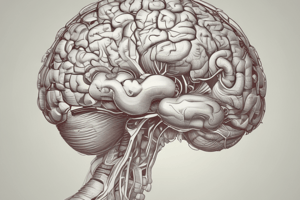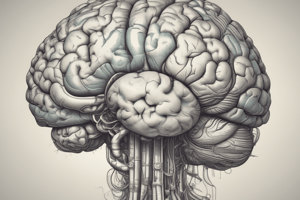Podcast
Questions and Answers
What is the primary characteristic of Frontotemporal Dementia?
What is the primary characteristic of Frontotemporal Dementia?
- Significant memory loss
- Changes in personality and behavior (correct)
- Severe language impairments
- Visual hallucinations
Which of the following is a prominent symptom of Progressive Nonfluent Aphasia?
Which of the following is a prominent symptom of Progressive Nonfluent Aphasia?
- Frequent paranoid hallucinations
- Severe short-term memory loss
- Difficulty with speech production (correct)
- Poor visual recognition
Which condition is specifically associated with Pick's Disease?
Which condition is specifically associated with Pick's Disease?
- Severe episodic memory loss
- Cortical neuron death (correct)
- Executive function deficits
- Vascular abnormalities in the brain
Which type of dementia is characterized primarily by loss of semantic memory?
Which type of dementia is characterized primarily by loss of semantic memory?
Vascular Dementia primarily results from what underlying issue?
Vascular Dementia primarily results from what underlying issue?
Which of the following is NOT a commonly recognized symptom associated with Semantic Dementia?
Which of the following is NOT a commonly recognized symptom associated with Semantic Dementia?
What early changes are characteristic of Pick's disease that help differentiate it from Alzheimer's disease?
What early changes are characteristic of Pick's disease that help differentiate it from Alzheimer's disease?
Which of the following statements about Alzheimer’s Disease is TRUE?
Which of the following statements about Alzheimer’s Disease is TRUE?
Where does brain atrophy primarily occur in semantic dementia?
Where does brain atrophy primarily occur in semantic dementia?
Mild Cognitive Impairment differs from dementia in that it does not usually affect what aspect of a patient's life?
Mild Cognitive Impairment differs from dementia in that it does not usually affect what aspect of a patient's life?
In progressive nonfluent aphasia, which is a typical characteristic of brain atrophy?
In progressive nonfluent aphasia, which is a typical characteristic of brain atrophy?
What distinctive symptom is associated with Huntington's disease?
What distinctive symptom is associated with Huntington's disease?
What can cause vascular dementia?
What can cause vascular dementia?
Which of the following is a symptom of vascular dementia?
Which of the following is a symptom of vascular dementia?
What neuropathological feature is associated with Pick's disease?
What neuropathological feature is associated with Pick's disease?
Which of the following is NOT a typical symptom of progressive nonfluent aphasia?
Which of the following is NOT a typical symptom of progressive nonfluent aphasia?
Which of the following symptoms is most commonly associated with Pick's disease?
Which of the following symptoms is most commonly associated with Pick's disease?
What type of language deficits are commonly observed in progressive nonfluent aphasia?
What type of language deficits are commonly observed in progressive nonfluent aphasia?
How does frontotemporal dementia primarily differ from Alzheimer's disease?
How does frontotemporal dementia primarily differ from Alzheimer's disease?
Which area of the brain is typically spared in frontotemporal dementia?
Which area of the brain is typically spared in frontotemporal dementia?
What characterizes the late stage of Alzheimer's disease?
What characterizes the late stage of Alzheimer's disease?
Which of the following statements accurately describes semantic dementia?
Which of the following statements accurately describes semantic dementia?
What is a common behavioral change observed in patients with frontotemporal dementia?
What is a common behavioral change observed in patients with frontotemporal dementia?
Which of the following best describes vascular dementia?
Which of the following best describes vascular dementia?
Flashcards
Pick's Disease Feature
Pick's Disease Feature
Characterized by personality changes, inappropriate behavior, memory loss without language problems, and neuronal damage (pick bodies and ballooned neurons).
Semantic Dementia location
Semantic Dementia location
Brain atrophy mainly in the left anterior temporal pole, affecting semantic memory (word meaning).
Progressive Nonfluent Aphasia Location
Progressive Nonfluent Aphasia Location
More damage to the left hemisphere than right hemisphere, also involves memory problems.
Huntington's Disease
Huntington's Disease
Signup and view all the flashcards
Vascular Dementia Symptoms
Vascular Dementia Symptoms
Signup and view all the flashcards
Vascular Dementia Progression
Vascular Dementia Progression
Signup and view all the flashcards
Multi-infarct Dementia
Multi-infarct Dementia
Signup and view all the flashcards
Mixed Dementia
Mixed Dementia
Signup and view all the flashcards
What are the two types of Alzheimer's lesions?
What are the two types of Alzheimer's lesions?
Signup and view all the flashcards
What happens to the brain in Alzheimer's?
What happens to the brain in Alzheimer's?
Signup and view all the flashcards
What are the stages of Alzheimer's?
What are the stages of Alzheimer's?
Signup and view all the flashcards
What is Frontotemporal Dementia?
What is Frontotemporal Dementia?
Signup and view all the flashcards
What is Pick's Disease?
What is Pick's Disease?
Signup and view all the flashcards
What is Progressive Nonfluent Aphasia?
What is Progressive Nonfluent Aphasia?
Signup and view all the flashcards
What is Semantic Dementia?
What is Semantic Dementia?
Signup and view all the flashcards
Right Hemisphere Lesions
Right Hemisphere Lesions
Signup and view all the flashcards
Anosognosia
Anosognosia
Signup and view all the flashcards
Working Memory
Working Memory
Signup and view all the flashcards
Semantic Memory
Semantic Memory
Signup and view all the flashcards
Episodic Memory
Episodic Memory
Signup and view all the flashcards
Dementia
Dementia
Signup and view all the flashcards
Mild Cognitive Impairment (MCI)
Mild Cognitive Impairment (MCI)
Signup and view all the flashcards
Alzheimer's Disease
Alzheimer's Disease
Signup and view all the flashcards
Study Notes
Right Hemisphere Disorder
- Considered a less significant aspect of human evolution compared to the left hemisphere.
- Largely overlooked until the 1960s, when corpus commissurotomy (cutting the corpus callosum) allowed for the study of each hemisphere's functions.
- Normal right hemisphere functions involve nonlinguistic communication aspects such as prosody, facial expressions, and body language.
- Important for emotional expression, visuospatial skills (perception and relationships), and understanding the bigger picture.
- Right hemisphere disorders involve deficits due to right cerebral hemisphere damage. These are often cognitive-communication disorders instead of aphasia.
- Language abilities are usually intact if the left hemisphere is unharmed but non-linguistic communication cues are essential for social communication.
- Common causes include stroke, seizure disorders primarily in the right temporal lobe, infection, and other diseases.
Communication Deficits
- Communication deficits in right hemisphere disorders manifest as issues with pragmatics (proper communication).
- Areas affected include comprehension/production of prosody, facial expressions, and inferencing/discourse.
- Difficulty in correctly interpreting these cues can lead to misunderstanding.
- Individuals can recognize a person but have difficulty understanding the bigger picture or relational details.
Facial Recognition/Prosopagnosia
- Facial recognition is a specific and complex skill, sometimes disrupted.
- Prosopagnosia (facial blindness) is the inability to recognize faces, due to damage to visual association areas of the occipital lobe, not visual impairment itself.
- Individuals may recognize objects but not faces.
Attentional Deficits (Neglect)
- Inability to attend to sensory stimuli from one side of the body or environment is known as neglect.
- Most commonly, the left side is overlooked.
- Neglect can affect spatial recognition and object acknowledgement for the impacted side and often involves multiple sensory modalities to varying degrees.
Prosodic Deficits
- Prosody in speech involves pitch, stress, timbre, and tempo, enriching speech with emotional context.
- Right hemisphere damage can impact the comprehension and production of prosodic components thus leading to monotone speech.
- This affects the ability to express and interpret emotions conveyed through speech which leads to communication difficulties.
Inferencing Deficits
- Trouble correctly interpreting and applying prior knowledge in the context of current events or information.
- Impacts understanding nuances like sarcasm, humor, and other nonliteral language which negatively impacts communication.
Discourse Deficits
- This involves the communicative exchange between speaker and listener and is commonly impacted by a damaged right hemisphere.
- Shared background knowledge is not properly recognized, and difficulties with turn-taking and message clarity may occur.
Visuospatial Deficits
- Damage to brain regions can impair the ability to perceive multiple details simultaneously.
- Simultagnosia is specifically the difficulty in processing multiple visual stimuli simultaneously.
Toxicity
- The severity of the deficit depends on the extent of brain damage.
- Small lesions can create localized issues, while larger ones affect multiple cognitive areas.
Dementia
- Dementia involves the global and progressive loss of brain function.
- It's a syndrome, rather than a specific disease; a range of conditions can cause it.
- Includes notable memory impairments, but also other deficits in activities of daily living (ADLs).
- Several types of dementia exist, including Alzheimer's disease, Huntington's disease, vascular dementia, and frontotemporal dementia.
- Key features of Alzheimer's include memory and language issues due to neurofibrillary tangles and amyloid plaques.
Studying That Suits You
Use AI to generate personalized quizzes and flashcards to suit your learning preferences.


